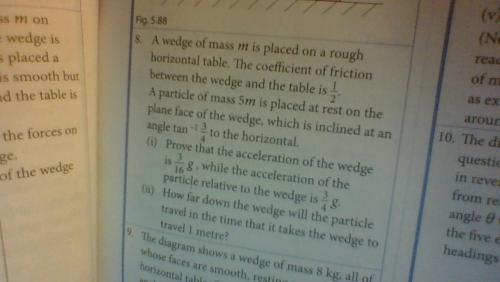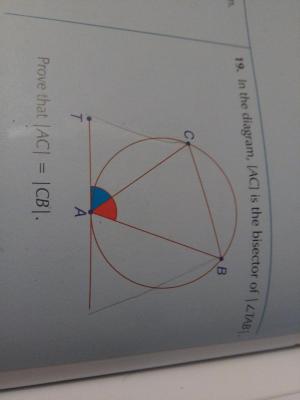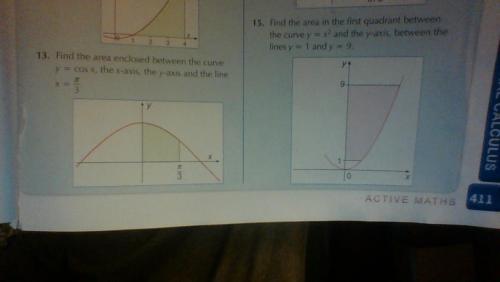

markosheehan
Members-
Posts
20 -
Joined
-
Last visited
Content Type
Profiles
Forums
Events
Everything posted by markosheehan
-
were my first 2 equations right
-
im stuck on question 8. the equation i got for the wedge is .6R -.5S=ma r stands for relative force of the particle s stands for relative force of the wedge . i got the equation 4mg-R=5m(.6a) for the particle where a stands for acceleration of the wedge. does anyone know where to go from here. are my equations wrong?. i drew a diagram of the forces
-
how can you change 2.5at^2 into sqaure root s/2 where s stands for the distance . i am very very confused , thanks for your help though
-
a train accelerates uniformly from rest to a speed v m/s with uniform acceleration a m/s^2 it then decelerates uniformly to rest with uniform retardation 3a m/s^2. the total distance travelled is s metres. if the average speed for the whole journey is square root (s/2) find the value of a. does anyone know how to work this out using uvast equations.
-
thanks for your help
-
Two particles of masses 3 kg and 5 kg are connected by a light inextensible string, of length 4 m, passing over a light smooth peg of negligible radius. The 5 kg mass rests on a smooth horizontal table. The peg is 2.5 m directly above the 5 kg mass. The 3 kg mass is held next to the peg and is allowed to fall vertically a distance 1.5 m before the string becomes taut. does any one know what this question looks like i cant even imagine it
-

Proving angles are equal in i triangle in a circle.
markosheehan replied to markosheehan's topic in Mathematics
i know that it means the red angle and the blue angle are the same but i dont know where to go from there -
hi can someone help me work this out. i think it has something to do with the exterior angle of a triangle is equal to the sum of the interior angles but i cant work it.
-
A particle travels srating with a initial speed u, with uniform acceleration a. Show that the distance travelled during the nth second is u+an-.5a. I tried working this out by putting this information into the formula S=ut+.5at^2 but it did not work
-
can some one help me with question 15. i am integrating it and trying this 1/3 (9)^3 -(1/3 (1)^3) and this gives me a answer of 242.66667 but the answer at the back of the book is 17 2/3
-
A car, starting from rest and travelling from p to q on a straight level road, where | pq | = 10 000 m, reaches its maximum speed 25 m/s by constant acceleration in the first 500 m and continues at this maximum speed for the rest of the journey. A second car, starting from rest and travelling from q to p, reaches the same maximum speed by constant acceleration in the first 250 m and continues at this maximum speed for the rest of the journey. (i) If the two cars start at the same time, after how many seconds do the two cars meet ? Find, also, the distance travelled by each car in that time. i am trying to use uvast equations to solve this but i cant. can someone help me
-
consider the function y=a^x where a is a constant. show that x= ln y/ ln x i tried using the log formula but i have had no luck can someone help me please
-
a uniform rod has length 6l and mass m. an axis is a distance l from the end perpendicular to the length of the rod . find the moment of inertia of the rod about this axis. can some1 show me how to find this.
-
is the function x²+3 surjective for real numbers. how do you test for surjectivity in general?
-
yes i tried integration \frac{dy}{y}= cos(x)dx but then i get ln(2)=sinx+c and then when i put in 2 for y and π /6 for x i get ln(2)=1/2 + c and this is not the answer the answer is y=2e^sinx-0.5
-
given the differential equation dy/dx=y cosx find the general solution given that y=2 when x= π /6 i cant solve this
-
Solve the differential equation ydy/dx =x+xy^2 given that y = 0 when x = 0. i can get down to here but then i get stuck dy/dx= x(1+y^2)/y ∫▒y/(1+y^2 ) dy=∫▒ x dx i dont know how to integrate this?
-
what is the effect of product differentiation on the AR and MR curves of a firm that previously operated under conditions of perfect competition
-
a subcommittee of three people is to be chosen from a committee of 10. (i)how many subcommittees are possible? (ii)how many subcommittees are possible if two particular people on the committee refuse to work together on the subcommittee? (iii)if the subcommittee is chosen at random what is the probability that the two people who refuse to work together will both end up on the same subcommittee i can work out the first question it is 10nCr3 which gives a answer of 120 but i cant work out the rest of the question
-
hi i cant work this out Its is estimated that 0.3% of a large population have a particular disease. a test developed to detected the disease gives a false positive in 4% of tests and a false negative in 1% of tests. a person is tested positive for the disease. what is the probability that the person actually has the disease? i was told my teacher that the answer is (probability of having the disease)/(probability the test is positive) i can work out the probability of having the disease but i cant work out the probability of the test being positive the probability of having the disease is .003. what is the probability of the test being positive i cant work this out. orginally i added .04 (probability the test is positive) and .99(probability test is positive, i got this from taking 1-.01) but that leaves you with a probability of the test being positive of 1.03 and i dont think this is possible. my teacher told me you get the answer by (probability of having the disease)/(probability the test is positive).




